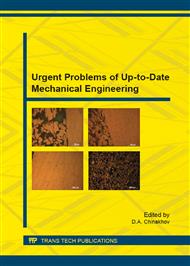[1]
G.S. Andreev, The stress state of the cutting part of the cutter with periodic cutting, Durability of the cutting tool, Moscow, 1969, pp.28-37.
Google Scholar
[2]
A.I. Betaneli, Communication method of calculating the strength of the cutting part of the tool, Bulletin of engineering. 2 (1965) 16-18.
Google Scholar
[3]
V.F. Bobrov, Determination of stresses in the cutting part of the cutting tools, High-performance cutting in mechanical engineering, Moscow, 1966, pp.228-233.
Google Scholar
[4]
A.M. Geniatulin, Holographic method research strained elements of assorted cutters, Optical-geometrical methods in the study of deformations and stresses and their standardization, Gorky, 1982, pp.83-84.
Google Scholar
[5]
M.B. Gordon, Methodology and some results of a study of patterns of distribution of the friction forces and tangential stresses on the contact length of the chip from the front surface of the cutter, Issues in the application of cutting fluids in machining metals, Ivanovo, 1965, pp.41-44.
Google Scholar
[6]
V.A. Kuznezhov, Technological processes in mechanical engineering textbook for use in the learning process of educational institutions implementing programs of vocational education - Moscow, (2009).
Google Scholar
[7]
O.S. Lomova, Mathematical modeling of structural changes in the surfaces of the workpieces at thermal perturbations in the process of sanding, J. Omsk scientific bulletin. 2(120) (2013) 95-98.
Google Scholar
[8]
S.I. Petrushin, I.M. Bobrovich, M.A. Korchuganova, Optimal design of the shape of the cutting blade tools, Tomsk, (1999).
Google Scholar
[9]
M.F. Poletika, M.H. Uteshev, Study of the processes of cutting the polarization-optical method, Bulletin of the Tomsk Polytechnic Institute, 1964, pp.114-115.
Google Scholar
[10]
S.I. Takhman, Patterns of wear and forecast basis the wear resistance of tools from the standard hard alloys. Mechanics and physics of processes on the surface and in the contact of solid bodies, parts of technological equipment. 3(2010) 64-72.
Google Scholar
[11]
V.G. Shalamov, Mathematical modeling in machining of metals, Chelyabinsk, (2007).
Google Scholar
[12]
A.S. Yanushkin, S.O. Safonov, D.V. Lobanov, Improvement of technological processes of machine-building productions, Bratsk, (2006).
Google Scholar
[13]
A.I. Afonasov, A.A. Lasukov, Elementary Chip Formation in Metal Cutting, J. Russian Engineering Research. 3 (2014) 152–155.
DOI: 10.3103/s1068798x14030034
Google Scholar


